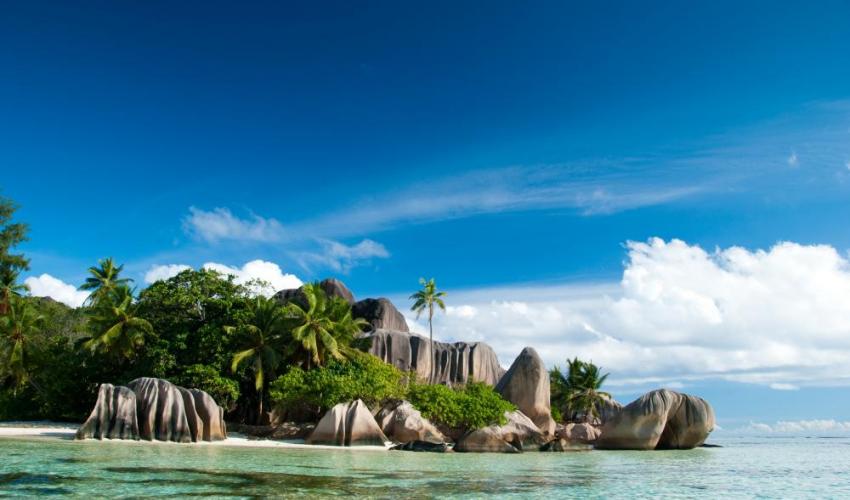Jean-Paul Adam, Minister of Finance, Trade and the Blue Economy of the Republic of Seychelles, discusses how debt swaps can build a Blue Economy by mobilising capital to support climate change adaptation and marine protection.
My island home of Seychelles is surrounded by a vast blue ocean teeming with marine life. Our Exclusive Economic Zone is almost 1.4 million km2, making the ocean the central driver of our economy and future. Our beautiful beaches and coral reefs are so rich that they attract tourists from all around the world and our fisheries provide sustenance for millions of people. Seychelles is also home to passionate leaders dedicated to advancing sustainable development, which in Seychelles means building a resilient Blue Economy.
To make our Blue Economy a reality, Seychelles has committed to protect 30% of our EEZ with half that area in high and medium biodiversity protection areas to support long-term protection of key species and habitats to improve resiliency of coastal ecosystems in the face of climate change as well as ensure economic opportunities for fisheries, tourism and other uses. This network of protected areas, equivalent to the size of Germany, was made viable through our Government concluding a pioneering debt-for-adaptation swap announced during COP21 in Paris.
The debt swap we have launched with the help of our partners is an innovative way to mobilize public and private capital to address climate change adaptation, marine protection and build a Blue Economy. Seychelles is a small country but we are showing the world that bold new approaches and strong partnerships can create the kind of solutions our planet needs.
Figuring out what we have, to prioritize what to protect
At Rio+20, our Vice President Danny Faure foreshadowed our Government’s 30% marine protection commitment based on a successful debt swap. This spurred action toward a better understanding of what was in our oceans. With support from The Nature Conservancy and Government of Seychelles (GoS)-UNDP-GEF Programme Coordination Unit, the GoS developed a comprehensive marine spatial plan for our entire EEZ, a first for the Western Indian Ocean.
The science-based marine spatial plan, designed with considerable public input, provides our Government with an integrated, multi-sector tool to guide policy and economic development to support the sustainable and long-term use and health of the waters throughout Seychelles.
Once implemented by 2020, the plan will place in 15% of Seychelles’ waters in high biodiversity protection zones, 15% in medium biodiversity protection zones and compatible uses, providing protection for critical species and habitats. Moreover, because the plan encompasses all of Seychelles’ EEZ, it will improve management for fisheries and tourism and collect crucial data through a spatial data catalogue and ‘MSP Atlas’.
Swapping our Debt to Save our Ocean
To create this sustainable source of funding to manage and implement our network of Marine Protected Areas and advance our Blue Economy, our Government reached a landmark agreement with its Paris Club creditors that resulted in a $21.6 million debt-for-adaptation swap. Designed with the support of The Nature Conservancy through the Global Island Partnership, the debt swap has enabled our Government to redirect a portion of their current debt payments to fund nature-based solutions to climate change including the Marine Spatial Planning Initiative that increases protection of our vast ocean from 1% to 30%.
The debt swap was designed to allow Seychelles to buy back $21.6 million of its debt at below market value from the creditors of the Paris Club countries with the help of a $15.2 million impact capital loan and $5 million of grants provided by The Nature Conservancy. This reduces the government’s annual debt service by an estimated $2 million, which makes these funds available for other needs of the Seychellois.
The Seychelles Government has set up a locally managed public-private trust, the Seychelles Conservation and Climate Adaptation Trust (SeyCCAT) that purchases and restructures the debt, manages the endowment and enforces the terms of the debt forgiveness agreement. The debt service payments will fund three distinct streams: one to repay impact investors, one to capitalize SeyCCAT’s endowment, and another to fund work on the ground that advances marine and coastal conservation, including strategies for ecosystem-based climate adaptation and disaster risk reduction. This is the first debt swap that specifically addresses climate adaptation and includes impact investors.
Sharing the Approach
Seychelles has been able to conclude this deal and leverage innovative financing to help achieve multiple development goals through strong political leadership and genuine, long-term partnerships. As with many Small Island Developing States, Seychelles has found it challenging to access finance to support climate change adaptation and sustainability goals. This debt swap provides a new financial mechanism for other countries and islands to mobilize financing for conservation and adaptation.
The Global Island Partnership led by our President, James Michel, alongside the President of Palau and Prime Minister of Grenada, has been a key platform to share successful island initiatives with other leaders around the world, and establish strong relationships such as with The Nature Conservancy. The upcoming World Conservation Congress in Hawai’i will be an important opportunity to share this innovative mechanism at the global level, show how islands are taking leadership and providing solutions to build a resilient and sustainable future.
I would like to acknowledge the following collaborators and funders for supporting Seychelles on the debt-for-adaptation swap.
Collaborators: Government of Belgium, Government of France, Government of Italy, Government of the United Kingdom, United Nations Development Programme, Global Environment Facility, Global Island Partnership
Funders: China Global Conservation Fund, The Jeremy and Hannelore Grantham Environmental Trust, Lyda Hill and the Lyda Hill Foundation, Oak Foundation, Oceans 5, The Nature Conservancy, Turnbull Burnstein Family Charitable Fund, Waitt Foundation.











